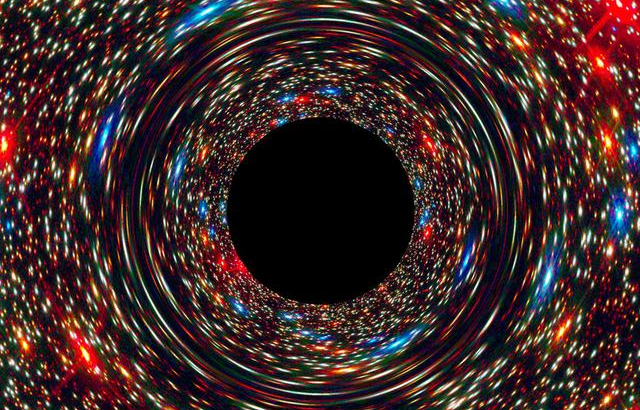Research led by the AU finds black holes could reach ‘stupendously large’ sizes
A recent study suggests the possible existence of ‘stupendously large black holes’ or SLABS, even larger than the supermassive black holes already observed in the centres of galaxies.

This computer-simulated image shows a supermassive black hole at the core of a galaxy. The black region in the center represents the black hole’s event horizon, where no light can escape the massive object’s gravitational grip. The black hole’s powerful gravity distorts space around it like a funhouse mirror. Light from background stars is stretched and smeared as the stars skim by the black hole. Credits: NASA, ESA, and D. Coe, J. Anderson, and R. van der Marel (STScI)
The research, led by Queen Mary Emeritus Professor Bernard Carr in the School of Physics and Astronomy, together with F. Kühnel (Münich) and L. Visinelli (Frascati), investigated how these SLABs could form and potential limits to their size.
Whilst there is evidence of the existence of supermassive black holes (SMBHs) in galactic nuclei – with masses from a million to ten billion times that of the Sun – previous studies have suggested an upper limit to their size due to our current view on how such black holes form and grow.
The existence of SLABS even larger than this could provide researchers with a powerful tool for cosmological tests and improve our understanding of the early Universe.
Challenging existing ideas
It has widely been thought that SMBHs form within a host galaxy and grow to their large sizes by swallowing stars and gas from their surroundings or merging with other black holes. In this case, there is an upper limit, somewhat above ten billion solar masses, on their mass.
In this study, the researchers propose another possibility for how SMBHs could form, which might evade this limit. They suggest that such SLABs could be ‘primordial’, forming in the early Universe, and well before galaxies.
As ‘primordial’ black holes don’t form from a collapsing star, they could have a wide range of masses, including very small and stupendously large ones.
Professor Bernard Carr said: “We already know that black holes exist over a vast range of masses, with a SMBH of four million solar masses residing at the centre of our own galaxy. Whilst there isn’t currently evidence for the existence of SLABs, it’s conceivable that they could exist and they might also reside outside galaxies in intergalactic space, with interesting observational consequences. However, surprisingly, the idea of SLABs has largely been neglected until now.”
“We’ve proposed options for how these SLABs might form, and hope that our work will begin to motivate discussions amongst the community.”
Understanding dark matter
Dark matter is thought to make up around 80 per cent of the ordinary mass of the Universe. Whilst we can’t see it, researchers think dark matter exists because of its gravitational effects on visible matter, such as stars and galaxies. However, we still don’t know what the dark matter is.
Primordial black holes are one of the potential candidates. The idea of their existence can be traced back to the 1970s when Professor Carr and Professor Stephen Hawking suggested that in the first moments of the Universe fluctuations in its density could have resulted in some regions collapsing into black holes.
“SLABs themselves could not provide the dark matter,“ said Professor Carr, “but if they exist at all, it would have important implications for the early Universe and would make it plausible that lighter primordial black holes might do so.“
More information
- Research publication: ‘Constraints on stupendously large black holes’ Bernard Carr, Florian Kühnel, Luca Visinelli, Monthly Notices of the Royal Astronomical 501, 2029-2043 (2021) arXiv: 2008.08077.